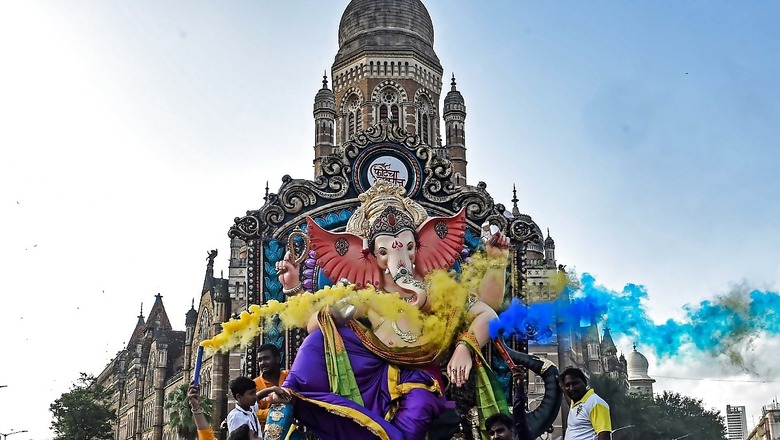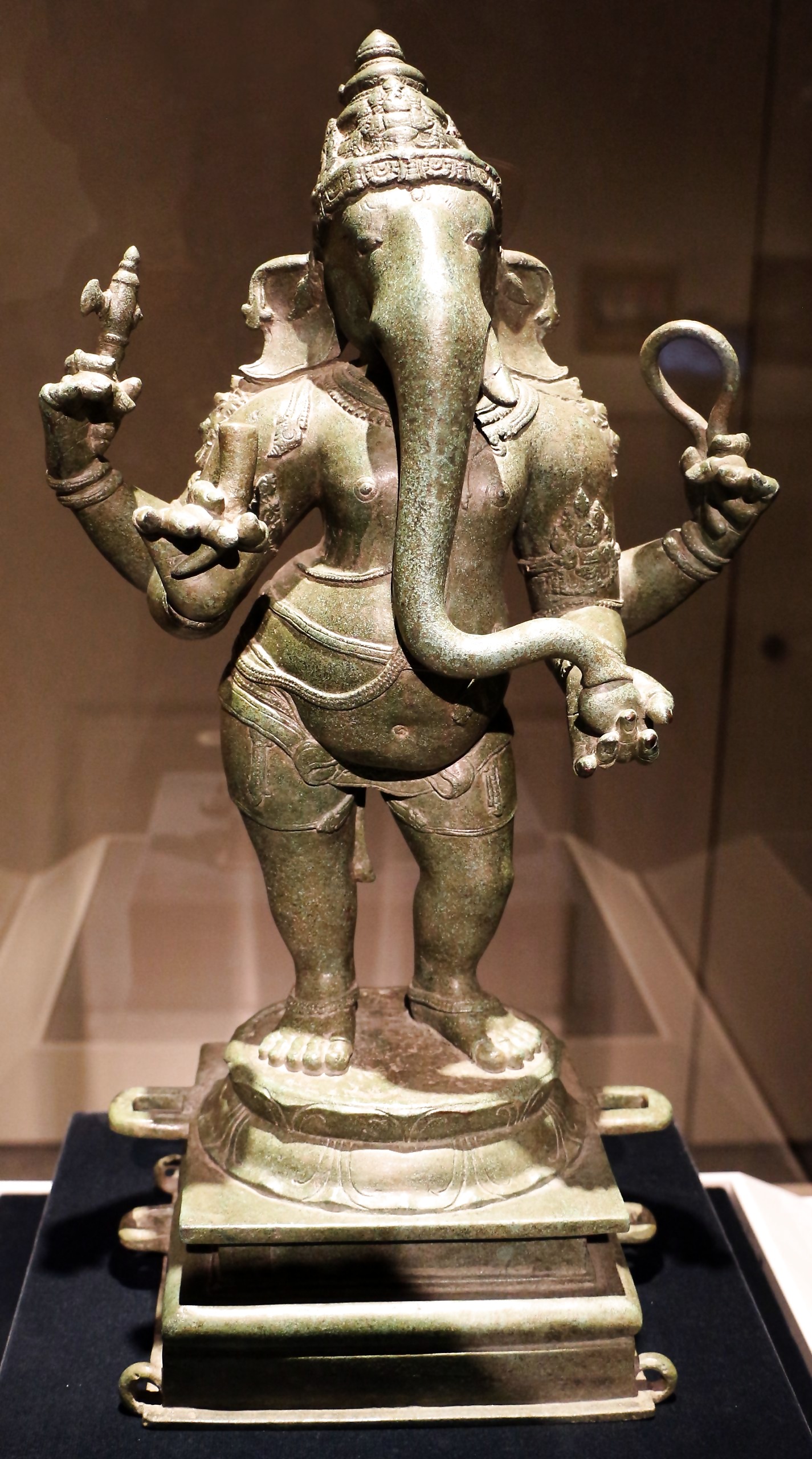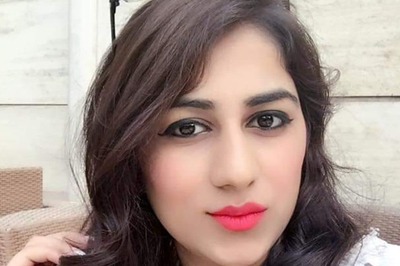
views
Recently, an advertisement of a biscuit brand sparked outrage on social media. The advertisement makes a case for women bringing home Bappa (how Ganesha is affectionately addressed in Marathi households). It takes a gendered outlook on the celebrations of Ganesh Chaturthi. The focus, initially, is on a girl child. It shifts later to the adult women in the household. The advertisement builds a ground for making a ‘beginning’ – which is – women carrying Bappa home instead of men. The girl child is shown pleading to take Bappa home. Just then, a male adult steps in to reform. Eventually and funnily, an adult woman takes Bappa home. Questioning traditions during festivals is the first refuge of the lazy, dull and doubtful. Advertisements often become an easy tool for imposing flimsy question marks on traditions.
Who will tell the ad-makers that the sight of a packet of biscuits shoved on the plate meant for ‘prasadam’ hurts more than a male of the family carrying Bappa home?
Hindu devotees on social media have expressed their disappointment over the biscuit advertisement based on Ganesha Chaturthi. The argument the biscuit advertisement seems to pose: Gowri – the mother of Ganesha herself takes him back home (after the Ganesh Chaturthi celebrations are over), and so, Bappa’s mother can take him for celebrations to the bhakta’s home. Fair, you might say. Not everyone thinks so. Their quibble: the advertisement indulges in virtue-signalling; that there is really no basis for it as because roles and tasks dedicated to preparations for the worship of Ganesha occur according to the nature of work, its demands and the time needed for preparations.
Here is something to ponder. If the advertisement really cared about keeping the (girl) child’s wish, it would have shown the child carrying Ganesha home – with some adjustments to the size and weight of the ‘devpratima’, of course. Ganesha, after all is children’s beloved deity. They adore him for his physical attributes and the modak in his hand. They are fascinated by his head, trunk, ears and the pot belly. His iconography establishes a deep connection with their innocence – even when they might not be aware of what “iconography” means. They consider Ganesha as their friend – thanks to their imagination and some modest attempts in connecting Ganesha to child-bhaktas in children’s films made on Ganesha.
The audience to such advertisements is divided. Many believe that in the recent past, by creating contemporary narratives in the garb of ‘breaking old barriers’, such advertisements have surreptitiously been placing doubt, culture-ambivalence and confusions in young minds amid festivities. The timing is not just odd, it is awfully divergent.
Several brands have launched advertisements using Deepawali, Ganesh Chaturthi, Holi, Rakshabandhan and even ‘kanyadaan’ (part of the Hindu wedding) for a background or setting, to deliver messages that happen to be in direct conflict with the spirit of the festival itself. They are greeted by outrage on social media. Mostly, at least in reason, the outrage is not out of place.
Questions pop up. What makes ad-makers so easily lured by the idea of changing customs? Why do they conveniently focus on children for the kind of messaging that takes the attention away from the festival itself? Why is it difficult to celebrate deities by celebrating traditions? Why, perhaps not co-incidentally, do children find a central role or character in such ads? Why did this advertisement, like other such, turn a child into a prominent vehicle for delivering the carefully-curated messaging? The pressure through such ads, seemingly, is to comply to the approval of a section that operates from a sense of intellectual superiority. The concern with the positive, or with the cultivation of vivid imagination in children, is either absent or too feeble.
As we look over possible answers, India and several known and unknown heroes are continuously working to bring back tangible wealth stolen from Indian temples from abroad. Among them are centuries old Chola-era sculptures of Ganesha. While Hindu tangible wealth has seen systematic plunder, the intangible heritage, of which the festivals, worship and celebrations are abode, too, are being subtly or directly pushed into conflicts.
Children must be ‘know’ before they are ‘informed’. They are the rightful recipients of India’s plundered sculptural wealth sitting abroad.
India under PM Modi has increased efforts towards the retrieval of its lost sculptural wealth. In June 2016, over 200 Indian artefacts stolen from Indian temples were returned to India by USA Attorney General Loretta E. Lynch. The artifacts were returned at a ceremony attended by Prime Minister Narendra Modi during his visit to the US. Among these artefacts was a bronze sculpture of Ganesha. It was estimated to be 1,000 years old. This Ganesha idol was moving evidence of the workmanship and devotion of the unknown artist of the Chola dynasty. A potential symbol of the “Gods returning home”, this idol, remarkable for the depiction of Ganesha’s trunk and its interaction with the deity’s hands, reflected the profound meanings in the names of Ganesha in the iconography.
Imagine for a moment if the biscuit advertisement celebrated Ganesha as “Gajakarna” for a concept that arrives at awareness on elephant conservation in India’s forests?

Ganesha is “Gajakarnaka” – the one with ears of elephant. He even carries a flag with a motif an elephant and hence gets the name “Gajapatirdhwaji”. Nature as part of his creation is congenital and ingrained in his interaction with trees, mountains, the seasons and flowers. He bears and holds within himself the five elements of nature. His name “Meghnad” brings in the aspect of clouds, their thunderous expanse. As “Buddhipriya” he is the one who praises wisdom. His thousand names reveal that he is adorned in ornaments — of gold.
What does Ganesha wear on his waist in these sculptures? Behold — those gorgeous amulets, necklaces and strings of ornaments twirling around his potbelly. You are less likely to see these marvellous and exquisite aspects inspiring advertisements.
It is important to assert that even though Ganesha is considered the harbinger of auspices and beginnings, the clamour for making beginnings should be about those beginnings that cultivate a deep spiritual engagement with worship and festivities, and not repulsion in the name of questioning traditions. There is a grand opportunity for it in turning children towards the knowledge of the names of Ganesha.
When children delve into the names of Ganesha, they will sculpt, in their imagination, drawing, or thinking, even their writing, their own kriti of the deity. That kriti of the deity itself created in the child’s mind after discovering the ocean of his names, will be in response to a silent communication with the imagery the names propel. As seen over the centuries, sculptures created in the Hindu civilisation reveal the immersive approach of the artist/sculptor into the expressions, ‘bhava’, demeanour, stance and countenance of the deity.
Consider for a moment that a child makes a transition — from her visual exposure to the ‘life-size’ or ‘larger than life’ depictions of Ganesha celebrated in Maharashtra – to a visual experience of the Chola era sculptures in an interaction enriched with the names of Ganesha. Would she not, in a moment, connect with answers to why Ganesha’s face is “serene”, or his forehead “radiant” with half that moon, or why his eyes are shown to be alert but benevolent?
He is “Vijayasthir” — always determined and meant to conquer. Ganesha is “Mahavira” — the immensely brave, courageous, valiant. Ganesha offers the opportunity to learn that the reserves of bravery are not disengaged from knowledge and wisdom. Though known for his proficiency in poetry, wisdom, knowledge and ‘naad’ (a concept in the philosophical understanding of sound and music). He is “Mantrine” – the master of all ‘mantras’. He is their creator, and the one who bears the knowledge of all ‘mantra’. He is “Pragya” – the one who is extremely intelligent. From Ganesha, children can learn that the savouring of knowledge and experiences that emerge from life events is not bereft of the joy in tasting the essence of their own happiness, inner prosperity, performance, rewards and above all, their devotion.
Ganesha is “Modakapriya”. He holds the “modaka” dear — literally. The pudginess of his hands holding the ‘modaka’ in all its roundedness and fullness — as seen in Chola era sculptures — reveals an endearing dimension of the deity to his devotees.
The telling and retelling of the Ashtottarashatanamavali – the 108 names of Ganesha, and the Sahasranama, will help children discover why the Chola sculptures were ‘valuable’ enough as artistic representations to be the ‘objects’ of worship and devotion and placed in the inner sanctums of temples. The visual and philosophical and devotional will meet.
The names of Ganesha will assert their own place in the children’s minds as the focal explanation to why the sculptures of Ganesha so conversantly indicate his role as the remover of obstacles. It might help them in understanding a positive approach to their own impediments. Their path to knowing the meanings in Hindu iconography must begin from their understanding of Ganesha. In order to understand their own role in the classroom, home, family, society, town, city, nation, universe, they must know Ganesha’s own role in the cosmic order and his own relation within his family and ‘environment’.
Children need to be connected to sculptures of the Chola era to know how Ganesha inspired the unknown sculptor to depict the intricate details in the iconography. The Chola era works depicting Ganesha are the visual vehicles to learn how the meanings in the names of Ganesha and the names themselves begin to reflect in art. A friendly familiarity with the names of Ganesha will route children’s understanding of depictions created in the pursuit of art in devotion themselves become central to worship, to temples where the worship is held and temple life that thrives owing to the presence of those sculptures.
The familiarity with the names of Ganesha will also prompt children to ask questions on why the focus on the worship of Shiva and Ganesha brought with it centuries of profound attention to their attributes. The prominence of Ganesha’s pot-belly in Chola sculptures, the curl of his trunk, the distinct edge-marked broken tusk held by Ganesha himself, the marked roundedness of the soft grip holding the ‘modaka’, the gentle tilt of the head even when the body stance is that of a born leader raring to take on the universe, the lasso and the weapon gripped in his other two hands.
These are visual representations of his own self, his demeanour and roles. The engrossing recurrence of Chaturbhuja Ganesha in Chola era sculpture needs to be introduced to and explained to children alongside the telling and retelling of his names.
Ganesha is often described to children as the “god of wealth and abundance.” For children, the visual dominance of Ganesha in Deepawali celebrations and the worship of Ganesha and Lakshmi during this festival of lights, helps build that connection with Ganesha being the “god of wealth and abundance.” Consider how a child would build her own perception of Ganesha as the “god of wealth and abundance” when she is made to explore his following names:
“Ganadhyaksha”. It denotes the status of Ganesha as the head – the adhyaksha – of the ganas. The name establishes him as a deity who himself is at the pinnacle of attributes. In names “Vighnaraja”, “Vighnakarta” and “Vighnaharta”, there is an element of duality in the name. ‘Vighna’ stands for troubles and hindrances. Ganesha, as “Vighnaraja” is the one who clears and destroys the obstructions. One way to understand the name is to delve into his ability to possesses the strength needed for demolishing obstructions. To demolish, he wields the power to controls troubles. Chew this for children. Ganesha bears the troubles so he can destroy them. During the years of growing and in life, troubles will arise. When confronted with belief, focus and will, those very troubles will be destroyed. “Vighnaraja” the name is particularly of value to children because it carries a message: arising and vanishing of troubles is cyclical. In the root of the trouble lies the possibility of the trouble itself getting destroyed.
So, “believe”, hang in there, don’t give up — not when you do not make it to a merit list, not when you ‘fail’ as per societal norms. Do not give up when the percentage is digits or double-digits less. Persist. Like Ganesha.
The trouble shooter is also the head of all things. “Vinayaka” and “Pramukha” stress on his position at the pinnacle of every creation of Prakriti as a deity, as deva. He is the boss, even when he is the baby of the most powerful father. He, like his father, and like Krishna, can create and sustain. That could be a child’s takeaway from devotion to Ganesha. The beauty of Ganesha resides in the name “Sumukha” – the one with the beautiful ‘mukha’ (face and mouth).
The aspect of beauty is the ultimate creative pursuit of devotee-artistes who give their all to creating poetry in metal and stone dedicated to that defining glimpse of Ganesha. He is “Kriti” himself — creation, form and the essence of creation, form and nature.
When children pause over the two names “Sumukha” and “Kriti” during their worship or glimpse of Ganesha, they might want to be quiet observers of Ganesha’s iconography itself — the eyes, ears, the head, the trunk, the “Ekadanta’s” tusk broken, in the depiction that is front of them, or in their mind. Beauty as an attribute of Ganesha will govern their notions of beauty as explained in popular culture and by peers. “Sukhanidhi” – the one who bestows bliss and happiness. There is a sense of an expanse of Ganesha’s ability to bestow happiness. It is inextricably linked to Ganesha being the symbol of prosperity, wealth and abundance.
Let children meditate over the calm in devotion. That calm could ride upon their pursuit of the arts or academic goals or skills they want to learn and align with. ‘Sukh’ is the destination in Ganesha’s pursuit, and he will bestow and provide. He is “Mahaganapati” – the supreme and the most powerful. What Mahaganapati helps achieve or what devotion for him may guide a child through, is an offering to him. He is “Heramba” — the dear, the loved, the adored child of his mother. Who can witness the devotion of the child better than “Heramba” himself?
Children today live in a world afflicted by short attention spans, paucity of patience, and a rubble of distractions around them. Usually, patience is a trait served to children as something they can draw from an activity or sport or a hobby. How would they understand patience as a strength in later stages of life? Why is patience and the ability to sustain it considered a defining strength in the greatest of warriors in the sacred texts and Indic history? Arjun displayed it on the battlefield as the war at Kurukshetra unfolded over Krishna’s eternal discourse.
There is no accurate substitute for the words “dhairyashaali” and “dridh”, but when one thinks of Ganesha, one finds a glimpse of these attributes in devotion. Because he is “Dhritimat”. It would not be a bad idea to introduce children to the idea of patience and sturdiness in thought and actions.
Ganesha is known as the one who fulfils wishes – “Kaamna”. It might lead a young mind to believe that devotion is the pivot to fulfilling desires. So be it. The end and means, regardless, is devotion and consistency at it. Names of Ganesha describe him as invincible, and the one who gets success.
Ganesha as “Jitamanmadha” turns the devotee to the deity who bears the power to control and keep in control desires. Needless to say, the rewards of keeping the focus on the pursuit of knowledge and the arts during adolescence and teen years, would go a long way in shaping the individual professional and personal life of a child in a skill-based transition that’s currently taking place. As “Vishwanetra” he has his beautiful eyes and sight on creation itself. The “Bhaktajivita” is watching the devotee. With that, he himself is the audience to the spiritual and intellectual progress made in the devotee.
The thousand names of Ganesha with their profound meanings, the multifarious nature of aspects as boundless as Ganesha himself, can keep a devotee engaged for a lifetime. Ganesha himself is “Dhyanam”, and the manifestation of Dhyana itself. He is the manifestation of Naad itself. He is “Kavi” – the poet. He is Yogadhipa – the one who masters Yoga.
Exuberance, enthusiasm, bliss, joy, happiness are not his attributes but his demeanor and identity as manifest in the Sahasranam. He is the ultimate “aim” and spiritual purpose of his own bhaktas. He also leads them successfully to their aims and goals. He resides in each and every rhythm.
With Ganesha, it’s always family first. He has his roles defined as “Umaputra”, “Kumarguru”, and “Ishanputra”. Ganesha’s bond with his mother is the core of his names “Shivashokahari”, “Gaurisukhavaha”, “Umangamalaja”, “Gauritejobhu”. Each name has a deeper meaning concealed in an umbilical and spiritual relationship with her being.
Making Ganesha synonymous with success is his name “Jishnu”. He is also known as “Vishnupriya” – dear to Vishnu. ‘Knowing’ the name can provide an anchor to understanding of the insurmountable helix of warmth that surrounds the deities, and this name, Vishnu’s affection for Shiva’s son. The view of Ganesha as “Vishnupriya” will help children dispel confusions that tend to rock their belief during adult years in peer narratives and social media bombardment of futile, politically-whetted, divisive dialogues, such as “who is more powerful among deities” and problematic hierarchy perceptions slapped on Hindu youth.
Views expressed in the above piece are personal and solely those of the author. They do not necessarily reflect News18’s views.




















Comments
0 comment